 April/May, 2018 - Vol. 31, No. 6.
April/May, 2018 - Vol. 31, No. 6.
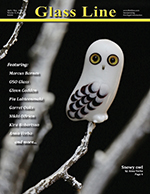
|
In This Issue
Snowy owl by Anna Verba
In working with glass, I am very exacting and self-critical. It is important to me that part of a face is symmetrical and accurate, the beak in the right place, the eyes are not simply spots. I concentrate all my attention on each stage. When the eyes do not turn out nice and symmetrical, I pluck the glass from the face with tweezers and make it again. Sometimes I have to redo the face several times, or the pattern of the wings become distorted, and the owl looks exhausted, weary. But sometimes it turns out well the first time, and I have what I call a “great owl day.”
...

Goblets allow for a seemingly infinite pursuit of perfection, balancing symmetry and complementary design. I have experimented with making goblets in borosilicate COE33 as well as the soda limes COE96 and COE104. In addition to the thin, hollow work of cup-making, I have grown fond of incorporating solid sculpture into goblets. It should be no surprise that I am greatly inspired by the work of Lucio Bubacco, whose style I am striving to resemble in my own work. I hope that this tutorial may help those who are intrigued by the wonder of glass to strive toward their goals in the same manner that I have pursued my lifelong passion for glass.
This tutorial demonstrates the final sculptural accents and connections for a goblet constructed using Effetre COE104. I blew the cup and foot from a solid gather using a mini blowpipe, similarly to the methods of Igor Balbi. I prepared the figure for the stem of the goblet ahead of time; this tutorial shows the final additions of the transparent green vines that serve a dual purpose: as part of the sculptural design and as structural support for the connection of the cup to the arms
...

I originally developed this claw design as a body part for an alien “lobster” as part of my “Fauna and flora of ancient Mars” series of whimsical creatures based on what life on alien worlds could look like, presented as scientific specimens. I created the “Sea Huntress Necklace” by making several claws in different sizes. I wanted it to look organic, as if it was made by someone who had strung together claws and shells found beachcombing on an alien shore.
I’ve turned this one into a pendant, but it could equally be used as part of your own sculptures or added to vases, bottles, pipes, candlesticks, etc., as handles or extra details. It can easily be scaled up or down by starting with a larger- or smaller-sized rod
...

Glass artists quickly understand the cost of color borosilicate glass. While clear is less than $10 per pound, color averages $65. Specialty colors commonly cost over the $100 mark. With such a drastic difference, artists often seek out techniques that combine color and clear to lower cost, while still providing a finished look of solid color. The technique demonstrated here coils color over clear tube in a way that is very fast, yet does not trap any bubbles.
There are additional benefits as well. The largest is a large saving in cost. For example, if a project requires a pound of glass, it would cost $65 to make if an average solid color was used. In this technique, the finished piece would be identical, yet the glass cost would be less than $25.
It is important to keep in mind that time is also an important factor in glasswork. Production using solid color tube can save enough time to increase production. Taking a close look at glass costs versus the quantity of pieces that can be produced is valuable. Putting this in perspective, it would not be logical to save $20 and an hour if it costs $50 in loss of production. This is where color tube comes into play, especially for larger pieces or when complex color patterns are needed, such as the tube created by Golden Gate Glass
...

A few years ago, I found a way to combine painting and lampworking by using fine silver to paint images on my beads. It is a fairly simple technique and it can be used on most beads.
This tutorial does not tell you how to make a bead. You can make a bead however you like — a bead of your own style. Just remember when making your bead that you are going to paint something on it later, so leave some space for the painting. One bead is waiting to be painted, another has been painted and kiln-annealed, and one is ready to use in jewelry
...
Flower Implosion Techniques for Marbles by Marcus Barnes
I am sharing some of the techniques I have become fond of in creating my pieces, in hopes of aiding and, where possible, inspiring other artists to experiment with the boundaries of this form. Thank you for taking the time to glimpse into some of my favorite flower implosion techniques
...
Octopus Pendant Tutorial by Kira Robertson
I have worked as a lampwork beadmaker for about 13 years now and still love it every bit as much as I did in the beginning. I feel compelled to continue creating these tiny treasures and honing my skills. Another aspect of what I do is the finished jewelry: combining my beads with high-quality findings for a finished product, or designing beads for a specific jewelry idea, is perhaps my favorite part. I love coming up with new designs and pushing my skill level. I continue to push myself; try new techniques, designs, and ideas; and look forward to learning new things
...

My style remains a work in progress, but along the way, I have come up with a combination of design elements that I enjoy putting together in one bead. I hope they will be of interest here.
‘Pop Art’ floral bead
I call this a “Pop Art” bead because the spotted background to the floral decoration reminds me of the dotted print effect in comic books (think Roy Lichtenstein)
...
|
 February/March, 2018 - Vol. 31, No. 5.
February/March, 2018 - Vol. 31, No. 5.
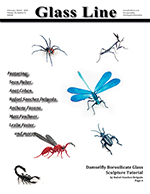
|
In This Issue
Damselfly Borosilicate Glass Sculpture Tutorial by Rafael Sanchez Delgado
Going against everyone’s recommendations and due to another strange and unknown reason, I leaned very early toward using borosilicate glass, a practice that I have continued ever since. Boro glass is the only material that I work with nowadays.
As a consequence of my inherent love for nature, and my many casual encounters with some key glass masters and their work, my own glasswork is inspired by living creatures, such as spiders, wasps, mantis, ants, beetles, snakes, etc. Most of my creations are only unassuming sculpture replicas of those so brilliantly created by Mother Nature.
In this tutorial, I share the process of making a damselfly, one of my favorite species and a subject matter that many friends and customers ask for regularly
...

I’m known mainly for making glass honeycombs, but they aren’t the only thing in my magic bag of tricks. Dichroic glass and I are great friends as well. Together with cubic zirconia, they fulfill my need for sparkle and glitter.
My color palette consists of bright, cheerful colors and lots of primaries, but this design also looks fabulous in earthier, more moody or dark base colors as well.
Including dichroic glass in your beads can be a bit of a challenge at first, but it is easily tamed once you know the basics. Applied properly, with the coated side down, you can use a generous amount of heat and manipulation with no fear that the sparkles will disappear.
Cubic zirconia is also easy to apply and a pretty addition to any design. This article shows how I apply them and provides some tips for using them successfully and — best of all — keeping them sparkly.
As with anything new, practice is the key to success, but play is equally important, so grab that dichro that’s been sitting around gathering dust and go for it
...

This is one of my personal favorite designs because it reminds me that we are all tiny universes, existing in a slightly larger universe that is equivalent to a subatomic particle in some other universe — like infinite information existing within a finite space
...

About a year ago, I decided to leave my hi-tech career behind, follow my heart, and become a full-time artist. My artwork is mostly inspired by the beauty of nature, taking and adding to it from my imagination. Cactus plants, in particular, have always fascinated me, with their endless shapes and colorful flowers. This article describes how to create one example of a glass cactus plant. You can use the same concepts to create them in numerous shapes and colors.
My favorite way to display my finished cactuses is creating mini-garden with one or two of them and some additional vegetation. As a base for a garden, I use either natural stone or a ceramic base that I make myself (in a stone-like shape or a tiny pot).
A few types of glue work well to stick a mandrel or glass parts to the base – either epoxy or silicon-based...

Shortly after I finished my second string of glassblowing classes, I stumbled upon YouTube videos about lampworking and was captivated by the thought that I could be working glass in my own home. Within a year, I had built my own bench top and was lampworking in my garage. Since then, I’ve been consuming as much information about lampworking as I can find. I started torch-working with simple implosions, jellyfish, and mushrooms. The vortex technique I use here is the condensed product of multiple experiments and has turned out to be one of my favorite designs so far
...

Since the beginning of my glass career, I have been captivated by, and focused on, gold and silver fuming. There is something about the way the fume holds sunlight that makes me smile. One of my favorite things to make are marbles. On Earth, only water and glass will bend light. As a result, spherical glass orbs have unlimited potential to draw the viewer into a unique and fantastic realm, all in the palm of your hand.
This tutorial is for what I call a kaleidosphere. It is a multi-layered, nearly all-fume marble that looks stunning on a marble spinner
...
|
 December/January, 2017/18 - Vol. 31, No. 4.
December/January, 2017/18 - Vol. 31, No. 4.
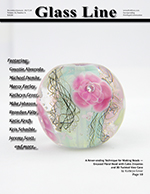
|
In This Issue
Essential Oil-holder Pendant by Jeremy Scott
I’ve been creating art for most of my life, in one form or another. I first discovered glass while attending art shows with my mother and uncle. My uncle knew a glassblower who created large, soft-glass vessels and invited us to glass shows he was featured in. We would walk into a showing and see art from wall to wall. I had never seen so much beautiful art in one place, and definitely realized that I was meant to create with more than just pencil or ink
...

For the last few years now, I have been focused on practicing more-evolved techniques and reverse-engineering the construction of flowers and other nature-related elements to make more-realistic varieties. This has meant that I have been working on murrini and cane of all sorts, combining these techniques with various dot-placement methods to create flowers with as much volume as possible. My inspiration often comes from photos of busy cottage gardens, big bouquets of mixed flowers, or anything with beautiful colors I have seen in everyday life. The results are still perfectible, but I am having a lot of fun and they are getting better with time.
This brings us to the subject of this tutorial, which is about delicate twisted cane, three encasing techniques, flowers — of course, and cubic zirconia. By no means can I say that I invented all the following methods, since we are all inspired by others at some point, but I have developed my own way of doing things and hope that this tutorial will be useful for some of our readers
...

In the summer of 2016, I was able to move to the area of the school, luckily only an hour from my hometown, and found a house with some friends where I was able to set up and blow glass full-time and began making pipes and pendants in my very first home studio. About six months later, I had a much better understanding of glass than previously, and branched out from pipes and implosion pendants to doing small sculptural stuff as well. Around Christmas of 2016, these holly ornaments were born.
As of late, I have been working mostly on pipes, always trying to come up with new color combinations and create functional glass that is different and has a unique color palette. I have always loved color and I like to think that definitely shows in most of my work
...

Preparation
Attach one 12 mm heavy wall tube to a 3.5-inch blank of 19 mm heavy wall tubing. This is what the line work will be applied to. Pull down 1-inch segments of color into stringers, roughly the size of a thick pencil lead. Colors I enjoy using for my initial lines are Cobalt 6 and Jet Black, since they stay saturated when pulled thin
...
Creating Galaxies with Color by Mike Johnson
As much as I love making pendants, people have wanted marbles for the last year or so, so that’s where I have been focusing my time lately. I like to make a few “styles,” I with the “Crushed Opal Galaxy” marbles being the most popular. I tend to make larger marbles, in the 1.5"–2.5" range, but also make some inexpensive “hider” marbles for people doing the marble hunt stuff
...

Over the past years, I have worked my way through the cane colors. Some have become my favorites and some have not. I love reaching to the back of my shelf and pulling out a blend that is older — it is like visiting a long-time friend.
Why did I fall so head over heels for this glass? Is it the way it moves when melted? Or the challenge of finding that single tiny piece for frit that finishes off the bead? Perhaps the color options? Maybe because I can get so much color in a bead with just a tiny jar and some clear? Whatever it is, I am so glad that door was opened for me. I hope this tutorial will help to open your creative door.
Writing this tutorial made me re-explore frit and how I came to love it so. I hope that you will begin to love frit as much as I do.
This style of bead best combines several of my favorite techniques for using frit. My other love is round beads — small, perfectly round beads. These techniques will work with whatever shape is your favorite
...

After graduation, I started doing bigger shows and my drops were always my best sellers. I started using the vitrograph to make my colorful cane, since I had no longer access to the dumpster and the hot shop at school.
I no longer do shows; I sell my earrings at several galleries and on Etsy. I also make other art, but I always come back to my drops. The drops have been good to me. Making them is like a mantra — no two are exactly alike. It is fun to pull yet another cane and see the promise of another beautiful pair of earrings.
I have tried, over and over again, to include dichroic glass in my drops, but the dichroic coating, especially the edges, would burn to a gray ash before the drop would fall. I asked other glassblowers how they included dichroic glass in their lampwork. “Encase it, and use a high-oxygen flame” was their advice. I still had a hard time making it work.
Then I heard about dichroic extract and it all came together. It really is simple; it always is in hindsight.
Here is how I made it work for me. Be free to use my technique. Be creative, be unique, but most of all, have fun
...

I began taking classes at the Glass Craft and Bead Expo in Las Vegas. Each year, I would have the incredibly humbling opportunity to take a different class with teachers like Bob Snodgrass, Eli Mazet, Josh Mazet, and Deb Crowley. I also like to take webinar tutorials; so many great artists there as well. Of course, to work with the boro glass, I needed to upgrade my torch, so now I use a Bethlehem Bravo and an oxygen concentrator. I love making marbles, pendants, rings, and small sculptures. I have my own home studio in northern Wisconsin.
This tutorial features a Honey Bee Flower compression marble, using a purchased Honey Bee millefiori (artist unknown)
...

While working with Jeremy, I practiced inside-out work and implosion techniques in my spare time to see if I could make the beautiful artwork I was seeing online and in glass shops. Over the course of two years, I was able to produce decent-looking marbles and pendants with varying patterns and designs in the glass, which inspired to keep pushing my artistic ability.
My favorite techniques, now eight years into my glass journey, are working with precious metals like gold and silver to achieve unique color combos and patterns using clear glass, which lets me achieve beautiful colors varying from pinks, purples, greens, and blues ...
|
 October/November, 2017 - Vol. 31, No. 3.
October/November, 2017 - Vol. 31, No. 3.
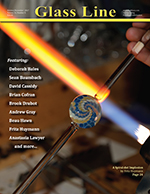
|
In This Issue

The design for my spider marbles started with my appreciation for Brad Pearson’s dot stack penguins, which inspired me to create an animal design for my marbles. I decided a spider design would be perfect for the technique. I had seen a spider design by Yoshinoro Kondo that seemed like a good place to start. Kondo’s dot stack spiders have large eyes like an ogre spider, mandibles, and short legs with a large body like a crab spider. He uses them in patterns, around the edge of a pendant or cabochon.
While I was inspired by Kondo’s design, it was important for me to make my spider design distinctly my own. My spiders are the center of the design, rather than part of a pattern. My spider body has a round abdomen with long, tan legs like a brown widow spider.
Another difference is that I make the cephalothorax of the spider very small and eyeless. My spider also has a shiny abdomen like a dewdrop spider. I use the same lensed Heavy Blue Leprechaun dot on most of my marbles, making it easily recognizable as a piece by me ...

I’ve had an incredible journey with glass. I lived in Corning, New York, for about two years and learned a lot there and met some amazing people. I feel blessed to have glass to express myself. I also find glassblowing to be therapeutic. I love learning and sharing. I look forward to doing some collaborations and attending any glass event I can. I’ll need more time to refine my fuming skills. That is the fun part for me. It’s the journey, not the destination.
I suggest experimenting with the angle of the implosion and thickness. Those factors affect the final result. With fuming silver, less is more ...

Now in 2017, I have only one year of steady glass art experience under my belt and I love every minute of it. Everything about the material wants to break on you and you’re constantly fighting a delicate balance with it. What I always say when someone who doesn’t know about glass asks me how I made something so nice is that, “Some people are gifted with the natural ability to sing or draw, but no one is gifted with the ability to manipulate glass.” Glass is such a foreign material that it takes time to become proficient and “perfect” this art.
My Coral Reef Pendants are not perfected in the slightest and I hope to improve them in the future. However, I have developed a process for making them clean and consistent ...

I graduated from the scientific glassblowing class in 2009. It was then that I decided to move away from the scientific side of lampworking and go for the freedom of a more art-related manner of working with glass. Furthermore, I decided to proceed with my formal glass education and enrolled in the course on craftsmanship and object design that is also taught at Kramsach. After two years of hard work and a lot of learning, I finally received my diploma.
Over the next couple of years, I took various classes at Bildwerk Summer Academy in Frauenaum Germany. These classes included not only lampworking, but also hot shop classes, giving me another perspective on working with hot glass. In September of last year, I was lucky enough to be asked to join the master class at the Graal Symposium in Bildwerk Frauenau, which was taught by Shane Fero. In this class, we combined these two techniques, which really opened my eyes to all that is possible with hot glass.
I began setting up my little home studio when I was still in school and it has been growing a bit more every year. I see all the classes I take and all the meetings I go to as an important part of my glass life. For me, glassblowing is a very social thing; talking, interacting, and learning from each other has become a vital part of my glass life. It brings me much more joy if I have somebody working with me in the same studio than when I’m working by myself...

As long as I’ve been working with glass, one of the most fascinating techniques I’ve seen has been murrine. You spend hours building up an image, not knowing whether it’s going to work or not. The most satisfying thing about murrine is cutting them open and revealing your hard work. After seeing examples by many other amazing artists, I decided to try my own, using similar techniques but on a smaller scale. Not knowing what the results would be, I dove in head first, and I encourage you to do so as well.
Like everything else in glass, there are many ways to do things. This tutorial covers the process I’ve developed, which has led to a very high success rate ...

In my artwork, I make visually identifiable objects as well as abstract ones. I use whatever method I feel conveys my message the best. These days, I mostly use glass; however, I am a mixed media artist who dabbles in various art media. My artwork is about conveying a message and giving the audience something to think about or relate to. It’s important for me to have an impact on people with my artwork and make them feel a certain way when they look at my pieces. I like to inspire people and change the way they look at things.
My main artistic inspiration is drawn from people and what’s going on in the world around me. My art allows me to express my thoughts, feelings, morals, experiences, or opinions about world issues. I want people to think or to feel a certain way when they see my art, whether it makes them happy, sad, angry, or even hungry. I hope my art can reach many viewers and can affect people’s thoughts and emotions; maybe even teach them something along the way. More often than not, I feel like my art represents my world, my past experiences, my everyday life, and I hope somewhere inside, people can relate to that. Art changed my life and gives me a voice that allows me to express myself ...

I am a glass artist living and creating in Winnipeg, Manitoba. I have studied at the Sheridan School of Craft and Design, Red Deer College, and Pratt Fine Arts Center. I incorporate elements of naturalist collections, botanical references, personalized ritual, and fairy tale imaginings into my glass to create work that is both familiar and otherworldly. Working with borosilicate and experimenting between flame-worked and blown glass, I often combine multiple small components together.
I’ve been making glass feathers for almost 10 years. I love the nearly endless possibilities of patterns and color combinations. You can create both realistic and fantastical feather styles in a variety of sizes. I often start off by creating a striped color base ...

Light reflects off the shape of the Luminance Light Pendant shape, giving the pendant a beautiful glow of color.
As a child, I spent most my days walking in the woods, singing, and writing. I love to create in virtually any artistic medium I can get my hands on, from singing to writing music and poems, to gardening and nature, all the while, extracting inspiration from this beautiful world. Glass is another medium of this artistic expression of my pure love of color (Earth) and light (Universe), which is defined through this beautiful planet. The Luminance Light Pendant is another expression, relating to light and color as I perceive it ...

One element of creating knobs for cabinetry, doors, dressers, etc. is critical: consistency. Building a collection of pieces that replicate one another to develop a cohesive grouping is one of the most-challenging aspects in the development of these items
...
|
 August/September, 2017 - Vol. 31, No. 2.
August/September, 2017 - Vol. 31, No. 2.
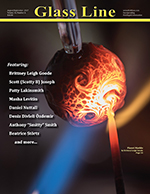
|
In This Issue
Making “Funny French Men” by Beatrice Störtz
I am inspired by anything colorful—a fabric, painting, nature, photography. I am also strongly attracted by masks and faces in general; 20 years ago, I used to make funny character puppets on a string. They usually had striking faces with great big noses. One day, I tried making my former puppet faces in glass. When my sons saw them, they both smiled and said “Hey, the French guys are back again!”
I made quite a few as one-hole beads for wine bottle stoppers and people loved them. After introducing them to my Facebook audience, they sold instantly there, too. There were also requests to make them threadable. This tutorial explains both.
In addition to making glass beads, I have taught myself to torch enamel on copper. As a jewelry designer, I know there is a demand for a combination of glass and enameled components. I also teach classes in both beadmaking and enameling “like a lampworker”
...

In the two years since I quit my job and started Oop Azi, my work has improved exponentially. It wasn’t easy at first; thankfully, my wonderful wife, Lena, helped keep us afloat until my art improved enough to actually make a living. Now, glass offers me almost limitless possibilities and I’m more than happy to pass along a bit of what I have learned.
Making a branching coral implosion pendant
The same steps for making a branching-type coral in a circular pendant can be used to make many different designs, but this is one of the most visually striking, unique-per-piece styles of implosion. It never ceases to impress...

This style is very organic in nature. It’s pretty hard to mess up. I prefer to use striking or reactive colors, but interesting effects could also be achieved with colors that are not reactive. Your frit choices are also pretty much up to you, but I consider clear frit a must (not just with these, but with boro in general. It’s amazing. Get some) and sometimes that’s all I use. In this case, I also added some GA Dragon’s Eye frit. I suggest keeping your flame neutral to slightly oxidizing while working, and then reduce once you melt in the Dragon’s Eye and clear frit.
Most of all, have fun! This is a super laid-back design, and one of my favorite things to make...

I believe that the learning process in glass is never-ending. I do my best to learn something new every day. Thanks to International Denizli Glass Biennial of Turkey, I attend workshops by famous and pioneer glass artists every two years, such as Lucio Bubacco, Gianni Toso, Simone Crestani, Tom Galbrait, Christian Arnold, and Julie Anne Denton. It was a great honor for my husband and me to be demo artists for the biennial in May 2017.
Nature inspires me. That is why I love making murrini and to reflect the colors and themes of nature in my works. With my murrini, I design flower gardens, colorful landscapes, vivarium, and galaxy beads.
This tutorial presents my rainbow rose murrini using Effetre/Moretti Italian soft glass rods.
The rainbow rose murrini has six layers. The first three layers use two different colors and the other three layers use three different colors...

I have only been making marbles for about a year, and I enjoy the challenges glass has to offer. Being self-taught, I may do things differently but that’s OK. It’s all trial and error, but that’s apart of the fun.
I use basic tools and a GTT Bobcat with a Jen Ken Chili Pepper kiln. I would like to share the steps I take to make one of my favorite marbles...

I work with different techniques: enamels, drawings, three-dimensional drawings in a transparent glass, and sculptured beads. I can’t say which technique I prefer over the others. Honestly, I love them all!
This article explains how I make a bead in the form of the national Japanese doll, Kokesy. Kokesy is usually made out of different types of wood. The doll is a girl with a cylindrical body and a round head, painted with a flowery pattern. Of course, my bead isn’t identical to the original Japanese toy, but I hope they look alike...

I started to take classes from nationally known beadmakers at Arrow Springs glass studio, and the techniques they taught excited me. I learned how to work with precious metal clay to make jewelry findings that were uniquely mine, and different techniques for ornamentation, making canes and twisties, working with reactive glass and foils, and much, much more that has found its way into my glass expression vocabulary.
I discovered the joys of collaborating with artists who do similar, and very different, work from what I do, and I discovered I love it. It’s soul- and mind-stretching, and I quite like the challenge. Each time I do this, I find myself learning a lot and finding new areas for my own work to expand and explore.
Lately I’ve been playing with the idea of words on lampwork beads, using the same techniques as for making signature cane. I’ve also been making (and teaching) headpin and cabochon techniques, and imagining new ways to combine hot glass and wire.
In my journey with glass, I’ve done a number of things that felt soul-stretching and helped me develop professionally as an artist. If I had to look back on my 14-year adventure and offer some advice to those just starting out, here are some things I would tell them, based on how it’s worked out for me...

I have become a staple in the glassblowing community with my jewelry, functional works, sculpture, and custom pieces. With 18 years’ experience and still learning, glass has been an infinitely intriguing medium that is becoming more and more liberating with every year that passes. In hopes of adding another 18 years to my glass experience, I continue to push myself further than I have ever gone in previous years
...
|
 June/July, 2017 - Vol. 31, No. 1.
June/July, 2017 - Vol. 31, No. 1.
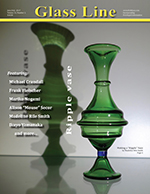
|
In This Issue
Making a "Ripple" Vase by Madeline Rile Smith
My favorite process on the torch is working with tubing to create hollow sculptures. I love the challenge and intimacy of working with a thin wall and shaping the medium with my breath. I usually make organic sculptures, called Arthropods, that are otherworldly exoskeletal forms with a menacing, yet delicate, quality. The rest of the time I like to create functional objects like blown vessels and cups, and pieces such as the ripple vases in this tutorial.
The act of focusing on the clean form of a utilitarian object clears my head and gives me satisfaction. It’s a refreshing process that clears up my way of thinking. I like to make these vases for demos because they are technically informative, yet there are many ways of improvising on them. These vases can be made on any scale; this tutorial uses a miniature size. One focus is adding texture to a hollow form by visualizing the torch flame as a “line” of heat
...

One particular technique that always intrigued me was fillacellos. The art of drawing lines on the side of a tube and flipping it into a pattern is mesmerizing. I have been using fillacellos in my work for a couple of years now, by adding them as caps on the bottom of rigs or incorporating them as sections in my larger pieces and collaborations. This tutorial explains how to make a fillacello pendant
...
Butterfly Wing by by Mariko Nogami
You can make two wings and enjoy them as a beautiful ornament or combine them with other things.
Use different color on Bordering or use opaque glass. Make your original color combinations and enjoy your own design of wings
...

I made lampwork accessories with silver, tableware, art objects with Boro glass, and glass beads with soft glass. In 1978, I began participating in exhibitions, both group and solo, and in 1992, I went to the Pilchuk Glass School in Stanwood, Washington, USA. For the last 15 years, I have been concentrating on making beads with soft glass. I have been living in the Greater Vancouver area for the those 15 years, where I have my own studio and enjoy making my beads every day. I sell my beads to customers around the world. Lately, I have started making and selling tutorials about some of my techniques for how to make murrini.
Even after all these years, I still find glass a fascinating medium to work with because it offers limitless possibilities and continually stimulates my creativity
...

I am a scientific glassblower at a university half the week where we make and repair scientific apparatuses. The other half of the week, I work in my studio at home. I live in northern Germany with my girlfriend and my two kids. I came across borosilicate glass art before my education as a scientific glassblower. A website that displayed all kinds of functional and non-functional glass art caught my attention and slowly I went down the rabbit hole...

I found that I enjoyed the process for compressions the most, and decided to focus on making flowers. Not long after the process “clicked” for me, I discovered Double Helix Color. A bit of research brought me to reduction glasses and the great effects that can be achieved with the natural reduction flame of the Hot Head torch. I began experimenting with the colors, first seeing what each would do on their own and then combining the colors to create new effects.
It was when I was showing my two-and-a-half-year-old daughter, Madeline, one of Daddy’s marbles, that I realized something about it was different. She sat transfixed, unable to look away. As I was turning it over for her to see, she kept giggling and telling me how pretty it was. I agreed, and knew I was onto something special. That something special is one of two Double Helix color combinations that I have fallen in love with, and would like to share with you
...
|
 April/May, 2017 - Vol. 30, No. 6.
April/May, 2017 - Vol. 30, No. 6.
|

